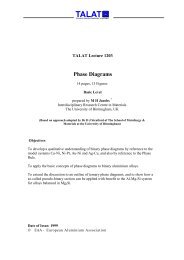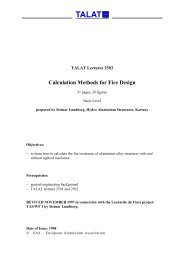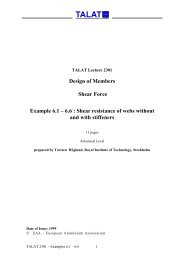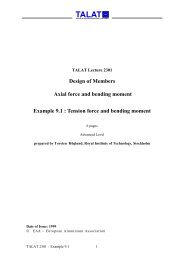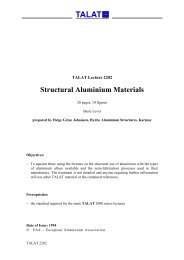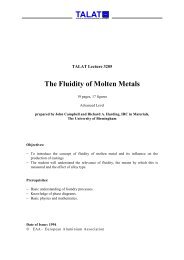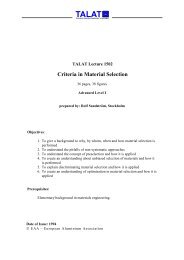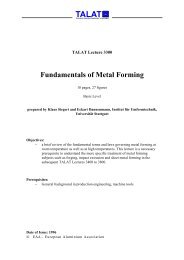Project Evaluation and Financing - MIT OpenCourseWare
Project Evaluation and Financing - MIT OpenCourseWare
Project Evaluation and Financing - MIT OpenCourseWare
You also want an ePaper? Increase the reach of your titles
YUMPU automatically turns print PDFs into web optimized ePapers that Google loves.
<strong>MIT</strong> <strong>OpenCourseWare</strong><br />
http://ocw.mit.edu<br />
1.040 <strong>Project</strong> Management<br />
Spring 2009<br />
For information about citing these materials or our Terms of Use, visit: http://ocw.mit.edu/terms.
1.040/1.401<br />
<strong>Project</strong> Management<br />
Spring 2009<br />
<strong>Project</strong> Finance<br />
Fred Moavenzadeh<br />
Department of Civil <strong>and</strong> Environmental Engineering<br />
Massachusetts Institute of Technology
Main Features<br />
<strong>Project</strong> <strong>Financing</strong><br />
Economically separable capital investment<br />
Cash Flow of the project the main source of the capital recovery<br />
Assets of the project is the only source used as collateral<br />
No recourse to the assets of sponsoring companies. Unless<br />
specifically required in the contract<br />
Debt serving has priority over investors equity<br />
During construction, interests on debt is accumulated as part of the<br />
debt.
Context: Feasibility Phases<br />
<strong>Project</strong> Concept<br />
L<strong>and</strong> Purchase & Sale Review<br />
<strong>Evaluation</strong> (scope, size, etc.)<br />
Constraint survey<br />
Site constraints<br />
Cost models<br />
Site infrastructural issues<br />
Permit requirements<br />
Summary Report<br />
Decision to proceed<br />
Regulatory process (obtain permits, etc)<br />
Design Phase
Equity<br />
Company<br />
<strong>Project</strong><br />
Equity<br />
Loan<br />
Finance<br />
Investment Firms<br />
Equity<br />
Loan<br />
Company<br />
<strong>Project</strong><br />
Equity<br />
<strong>Project</strong> Finance
Company Finance Vs. <strong>Project</strong> Finance<br />
Company Finance <strong>Project</strong> Finance<br />
Capital Formation Will impact debt capacity Will not impact debt<br />
capacity, because it is off<br />
balance sheet<br />
Risk Exposure Could impact overall risk<br />
structure or the cost of<br />
capital<br />
Limited<br />
Tax Shield Hard to take advantage of Easier to bundle<br />
Cash Flow To corporate treasurer:<br />
subject to corporate policy<br />
on dividend<br />
Directly to the investor<br />
Cost of <strong>Project</strong> <strong>Financing</strong> None High due to setting up cost<br />
Capital Cost Company’s track record High Due to no history<br />
Oversight by the Sponsors None Very Dem<strong>and</strong>ing
Strategic Objectives<br />
(Long Run)<br />
•Market Share<br />
•Growth Rate<br />
•Market Leadership<br />
•Technology Leadership<br />
Analysis of Financial<br />
Performance<br />
<strong>Project</strong> Decision<br />
•Does the project make financial sense?<br />
•Is the project within the overall strategic<br />
framework of the company?<br />
•If there is a clash between the objectives,<br />
has financial evaluation correctly taken all<br />
the costs <strong>and</strong> benefits into account?<br />
Financial Objectives<br />
(Short Run)<br />
•Return on Investment (ROI)<br />
•Return on Equity (ROE)<br />
•Return on Asset (ROA)
Profitability Ratios<br />
Liquidity Ratios<br />
Debt Ratios<br />
Activity Ratios<br />
Leverage Ratios<br />
Financial Ratios
Summary of Financial Ratios<br />
Profitability Ratios Liquidity Ratio Activity Ratios<br />
Gross Point Margin<br />
An indication of margin available to cover<br />
operating expenses <strong>and</strong> yield profit<br />
(Sales – Cost of Goods Sold) /Sales<br />
Operating Profit Margin<br />
An indication of firms profitability from<br />
current operations without regard to interest<br />
changes accounting from capital structure<br />
Profit Before Tax <strong>and</strong> Interest/Sales<br />
Net Profit Margin<br />
Shows after tax profit per dollar of sales.<br />
Subpart profit margin indicates that the firm<br />
sales prices are relatively low or that costs are<br />
relatively high or both<br />
Profit After Tax/Sales<br />
Return to Total Asset<br />
A Measure of total investment in the<br />
enterprise. It is sometimes desirable to add<br />
interest to alter tax profits to add form the<br />
numerator of the ratio since the total assets<br />
are financed by creditors as well as by<br />
stockholders; hence it is accurate to measure<br />
the productivity of assets by the returns<br />
provided to both classes of investors<br />
Profit After Tax/Total Assets<br />
Current Ratio<br />
Indicates the extent to which the claims of short<br />
term creditors are covered by assets that are<br />
expected to be converted to cash in a period<br />
roughly corresponding to the maturity of liabilities<br />
Current Assets/Current Liabilities<br />
Quick Ratio (Acid Ratio)<br />
A Measure of firms ability to pay off short term<br />
obligations without relying on the sale of its<br />
inventory<br />
(Current Asset-Inventory/Current Liability)<br />
Inventory to Newt Working Capital<br />
A measure of the extend to which the firm’s<br />
working capital ties up in inventory<br />
Inventory/(Current Assets- Current liabilities)<br />
Inventory Turnover<br />
When compared to industry averages,<br />
it provides an indication of whether a<br />
company has excessive/inadequate<br />
finished good invent.<br />
Sales/Inventory of finished goods<br />
Fixed Asset Turnover<br />
A Measure of sales productivity <strong>and</strong><br />
utilization of plant <strong>and</strong> equipment<br />
Sales/Fix Assets<br />
Total Assets Turnover<br />
A measure of utilization of all firm’s<br />
assets ratio below the industry average<br />
indicates the company is not<br />
generating a sufficient volume of<br />
business, given its asset size<br />
Sales/Total Asset<br />
LEVERAGE RATIOS Account Receivable Turnover<br />
Debt to Asset Ratio<br />
Measures the extend to which borrowed funds<br />
have been used to finance the firm’s operation<br />
Total Debt/Total Equity<br />
A Measure of the average length of<br />
time it takes the firm to collect the sale<br />
it made on credit<br />
Annual Credit Sale/Account<br />
Receivable<br />
OTHER RATIOS
Summary of Financial Ratios<br />
Profitability Ratios Liquidity Ratios Activity Ratios<br />
Return on Stockholders Equity<br />
A measure of the rate of return on<br />
stockholders investment in the enterprises<br />
Profit After Tax<br />
Total Stockholders Equity – Par Value<br />
Pref. Stock)<br />
Return on Common Equity<br />
A measure of the rate of return on<br />
investment which the owners of the<br />
common stock have made in the enterprise<br />
(Profit After tax-Preferred Stock<br />
dividends)<br />
[Tot. Stockholders Equity-par value Pref.<br />
Stock]<br />
Earning Per Share<br />
Shows the earnings available to the owners<br />
of each share of common stock<br />
(Profit After tax-Preferred Stock<br />
dividends)<br />
Number of Common Stocks Outst<strong>and</strong>ing<br />
Debt Equity Ratio<br />
Provides measure of the funds provided by<br />
creditors <strong>and</strong> equity in the firm’s long term<br />
capital structure<br />
Long Term Debt/Total Shareholders<br />
Long Term Debt to Equity Ratio<br />
A widely used measure of balance between<br />
debt <strong>and</strong> equity in the firm’s long term<br />
capital structure<br />
Long Term Debt/Total Shareholders<br />
Time Interest-Earned Ratio<br />
Measured the extent to which earnings can<br />
decline without the firm becoming unable<br />
to meet its annual costs .<br />
Profit Before Interest <strong>and</strong> Taxes/ Total<br />
Interest<br />
Fixed Cost Coverage<br />
A more inclusive indication of the firms<br />
ability to meet all of its fixed charge<br />
obligations<br />
Dividend Yield on Common Stock<br />
Measure of returns to owners received in<br />
dividends Annual Dividend per<br />
share/Current Market Price<br />
Price Earnings Ratio<br />
Faster growing or less-risky firms tend to<br />
have higher P/E than slower growing or<br />
risky firms<br />
Current Market Price/After tax Earning<br />
per share<br />
Dividend Payout Ratio<br />
Percentage of profits as dividends Annual<br />
Dividends share/After tax Earning share<br />
Cash Flow Per Share<br />
A measure of the discretionary funds over<br />
<strong>and</strong> above expenses that are available for<br />
use by the firm<br />
After tax Profits + Depreciation<br />
Number of Common Shares Outst<strong>and</strong>ing
Liquidity Ratios:<br />
Short term obligations:<br />
In Construction<br />
Account Payable<br />
Accrued Interest <strong>and</strong> Employee Benefits<br />
Advanced billings on contracts<br />
Short Term Assets<br />
Cash Accounts Receivable<br />
Inventory<br />
Contract in Progress
Relation Between Contracting Firm,<br />
Capital Investment &<br />
Working Capital<br />
<strong>Project</strong> Revenue<br />
Sponsor <strong>and</strong> <strong>Project</strong><br />
Contracting Firm<br />
<strong>Project</strong><br />
+<br />
+<br />
-<br />
Operating Cost<br />
Sponsor<br />
+<br />
Fund Transfer
Traditional <strong>Financing</strong> Structure<br />
Stockholders/<br />
Investors<br />
Investment in<br />
the Company<br />
+<br />
Profit<br />
+<br />
Dividend<br />
Sponsor<br />
+<br />
Loan<br />
+<br />
+<br />
<strong>Project</strong><br />
Banks <strong>and</strong><br />
Financial<br />
Institutions<br />
+<br />
Interest<br />
Capital Investment
Contractor<br />
EPC<br />
Contract<br />
Maintenance<br />
Contract<br />
Toll Payments<br />
Investors Lenders<br />
Equity<br />
Finance<br />
Proj.<br />
Company<br />
Concession<br />
Agreement<br />
Road Users Contracting<br />
Authority<br />
Toll Road <strong>Project</strong> Finance Structure<br />
<strong>Project</strong><br />
Finance Debt.<br />
Operation<br />
Contract<br />
Support<br />
Agreement<br />
Operator<br />
Government
Contractor<br />
Construction<br />
Contract<br />
Input Supply<br />
Contract<br />
Investors Lenders<br />
Equity<br />
Finance<br />
Proj.<br />
Company<br />
Off-take<br />
Contract<br />
Input Supplier Offtaker<br />
Simplified <strong>Project</strong> Finance Structure<br />
<strong>Project</strong><br />
Finance Debt.<br />
OR<br />
Operation &<br />
Maintenance<br />
Contract<br />
Concession<br />
Agreement or<br />
License<br />
Operator<br />
Support<br />
Agreement<br />
Government or other<br />
public-sector authority
$10,000,000<br />
$5,000,000<br />
$0<br />
($5,000,000)<br />
($10,000,000)<br />
($15,000,000)<br />
($20,000,000)<br />
($25,000,000)<br />
($30,000,000)<br />
($35,000,000)<br />
<strong>Financing</strong> – Gross Cashflows<br />
Design/Preliminary Construction<br />
years 1 2 3 4 5 6 7 8 9 10<br />
OWNER<br />
investment ($10,000,000) ($20,000,000)<br />
operation incomes $2,000,000 $4,000,000 $6,000,000 $6,000,000 $6,000,000 $6,000,000 $6,000,000<br />
owner cashflow $0 ($10,000,000) ($20,000,000) $2,000,000 $4,000,000 $6,000,000 $6,000,000 $6,000,000 $6,000,000 $6,000,000<br />
owner cum cashflow $0 ($10,000,000) ($30,000,000) ($28,000,000) ($24,000,000) ($18,000,000) ($12,000,000) ($6,000,000) $0 $6,000,000<br />
CONTRACTOR<br />
costs ($4,000,000) ($7,000,000) ($14,000,000) $0 $0 $0 $0 $0 $0 $0<br />
revenues $0 $10,000,000 $20,000,000 $0 $0 $0 $0 $0 $0 $0<br />
contractor cashflow ($4,000,000) $3,000,000 $6,000,000 $0 $0 $0 $0 $0 $0 $0<br />
contractor cum cashf ($4,000,000) ($1,000,000) $5,000,000 $5,000,000 $5,000,000 $5,000,000 $5,000,000 $5,000,000 $5,000,000 $5,000,000<br />
Owner investment = contractor revenue<br />
1 2 3 4 5 6 7 8 9 10 11<br />
owner cum cashflow<br />
contractor cum cashflow<br />
• Early expenditure<br />
• Takes time to get revenue
Multi-lateral, bi-lateral <strong>and</strong><br />
Export Credit Agencies<br />
Typical <strong>Project</strong> Structure for IPP<br />
Gas Input<br />
Under a supply<br />
contract<br />
Non-Recourse<br />
DEBT<br />
Inter-creditor<br />
Agreement<br />
Technol.<br />
License<br />
Labor<br />
Bank<br />
Syndicate<br />
Equipment<br />
Contract<br />
(turbines)<br />
70%<br />
Adapted from: Esty & Sesia; HBS Oct. 2007<br />
30%<br />
<strong>Project</strong> Company<br />
(Power Plant)<br />
Construction<br />
Contract<br />
(EPC Contract)<br />
Sponsor<br />
A<br />
Operating<br />
& Maint.<br />
Contract<br />
Sponsor<br />
B<br />
EQUITY<br />
Shareholder<br />
Agreement<br />
Board of Directors<br />
Power Output<br />
Under a purchase<br />
contract<br />
Sponsor<br />
C<br />
Host Government:<br />
legal system, permits,<br />
Regulation, property rights, etc.
Private Owners w/Collateral Facility<br />
Short<br />
Distinct <strong>Financing</strong> Periods<br />
Short-term term construction loan<br />
Bridge Debt<br />
Risky (<strong>and</strong> hence expensive!)<br />
Borrowed so owner can pay for construction (cost)<br />
Long-term Long term mortgage<br />
Senior Debt<br />
Typically facility is collateral<br />
Pays for operations <strong>and</strong> Construction financing debts<br />
Typically much lower interest<br />
Loans often negotiated as a package<br />
construction<br />
w/o tangible<br />
operation<br />
w/ tangible<br />
time
Typical Terms<br />
<strong>Project</strong> Company has to complete the project<br />
under the terms of contract<br />
Public Authority provides the l<strong>and</strong> <strong>and</strong> the right-<br />
of-way of way<br />
Ownership remains by the Public Sector<br />
Concession is given for limited period of time<br />
Operation <strong>and</strong> Management is in the h<strong>and</strong> of<br />
<strong>Project</strong> Company
<strong>Project</strong> Finance <strong>and</strong> Privatization<br />
<strong>Project</strong> finance should be distinguished from privatization,<br />
which:<br />
either conveys the ownership of public-sector public sector assets to the<br />
private sector-this sector this does not necessarily involve project finance;<br />
a privatized former state-owned state owned company may raise any<br />
finance required through a corporate loan.<br />
or provides for services to be supplied by a private company that had had<br />
previously been supplied by the public sector (e.g., street cleaning) cleaning)<br />
–<br />
again, this does not necessarily involve project finance: the private private<br />
company may not have to incur major new capital expenditure <strong>and</strong> so<br />
not require any finance at all, or may use a corporate loan to raise raise<br />
the<br />
finance to make the investment required to provide the service.
<strong>Project</strong> finance may come into the picture if a company needs<br />
finance for the construction of public infrastructure on the<br />
basis of a contract or license, e.g.,<br />
An Off-take Off take Contract, based on which a project will be constructed to sell sell<br />
its<br />
output to a public-sector public sector body (e.g., construction of a power station to sell<br />
electricity to a stat-owned stat owned power company)<br />
A Concession Agreement under which a project will be constructed to<br />
provide a service to a public-sector public sector body (e.g., provision of a public-sector<br />
public sector<br />
hospital building <strong>and</strong> facilities)<br />
A Concession Agreement under which a project will be constructed to<br />
provide a service to the general public normally provided by the public sector<br />
(e.g., a toll road)<br />
A Concession Agreement or license under which a project will be constructed<br />
to provide new services to the public (e.g., a mobile phone network). network).
Examples of other types of structured finance<br />
Receivables financing<br />
Securitization<br />
Leveraged buyout (“LBO ( LBO”) ) or management buyout (“MBO ( MBO”) )<br />
financing<br />
Acquisition finance<br />
Asset finance<br />
Leasing
Benefit of Leverage on Investor’s Investor s Return<br />
Low Leverage High Leverage<br />
<strong>Project</strong> Cost 1,000 1,000<br />
(a) Debt 300 800<br />
(b) Equity 700 200<br />
(c) Revenue from project 100 100<br />
(d) Interest rate on debt (p.a.) 5% 7%<br />
(e) Interest payable [(a)x(d)] 15 56<br />
(f) Profit [(c) – (e)] 85 44<br />
Return on equity [(f)÷(b)] 12% 22%
Payment schedule<br />
Contractor <strong>Financing</strong><br />
Break out payments into components<br />
Advance payment<br />
Periodic/monthly progress payment (itemized breakdown structure)<br />
Milestone payments<br />
Often some compromise between contractor <strong>and</strong> owner<br />
Architect certifies progress<br />
Agreed-upon payments<br />
retention on payments (usually, about 10%)<br />
Often must cover deficit during construction<br />
Can be many months before payment received
Man-hours<br />
S-curve curve Work<br />
months
$K<br />
8<br />
7<br />
6<br />
5<br />
4<br />
3<br />
2<br />
1<br />
0<br />
S-curve curve Cost<br />
1 2 3 4 5 6 7 8 9 10 11 12 13 14 15 16 17 18 19 20 21 22<br />
Working days<br />
100<br />
90<br />
80<br />
70<br />
60<br />
50<br />
40<br />
30<br />
20<br />
10<br />
0<br />
Cumulative costs $K<br />
Monthly cost<br />
Cum. costs
Expense & Payment<br />
Cumulative net<br />
cash flow (dollars)<br />
Amount (dollars)<br />
+<br />
_<br />
Contractor's<br />
expenses<br />
0 1 2 3 4 5 6 7 8 9<br />
(A) Expenses <strong>and</strong> payments<br />
Owner's payments<br />
Time period<br />
(month)<br />
0 1 2 3 4 5 6 7 8 9 Time period<br />
(month)<br />
(B) Cumulative net cash flow of contractor<br />
Image by <strong>MIT</strong> <strong>OpenCourseWare</strong>.
Revenue<br />
120<br />
100<br />
80<br />
60<br />
40<br />
20<br />
Contractor <strong>Financing</strong><br />
Owner keeps an eye out for<br />
0<br />
Front-end Front end loaded bids (discounting)<br />
Unbalanced bids<br />
Contractor Revenue <strong>Project</strong>ion<br />
1 2 3 4 5 6 7 8 9 10 11 12 13 14 15 16 17 18<br />
Month<br />
Revenue<br />
140<br />
120<br />
100<br />
80<br />
60<br />
40<br />
20<br />
0<br />
Contractor Revenue <strong>Project</strong>ion<br />
1 2 3 4 5 6 7 8 9 10 11 12 13 14 15 16 17 18<br />
Month
Contractor <strong>Financing</strong><br />
Owner keeps an eye out for<br />
Front-end Front end loaded bids (discounting)<br />
Unbalanced bids<br />
Contractors frequently borrow from<br />
Banks (Need to demonstrate low risk)<br />
Interaction with owners<br />
Some owners may assist in funding<br />
Help secure lower-priced lower priced loan for contractor<br />
Sometimes assist owners in funding!<br />
Big construction company, small municipality<br />
Sometimes assist owners in funding!<br />
Big construction company, small municipality<br />
BOT
Contractor <strong>Financing</strong><br />
Agreed upon in contract<br />
Often structure proposed by owner<br />
Should be checked by owner (fair-cost (fair cost estimate)<br />
Often based on “Masterformat<br />
Masterformat” Cost Breakdown Structure<br />
(Owner st<strong>and</strong>ard CBS)<br />
Certified by third party (Architect/engineer)
Latent Credit<br />
Many people forced to serve as lenders to owner due<br />
to delays in payments<br />
Designers<br />
Contractors<br />
Consultants<br />
CM<br />
Suppliers<br />
Implications<br />
Implications<br />
Good in the short-term short term<br />
Major concern on long run effects
Tax deductions for<br />
Depreciation -<br />
Depreciation<br />
Role of Taxes<br />
the process of recognizing the using up of an asset through<br />
wear <strong>and</strong> obsolescence <strong>and</strong> of subtracting capital expenses<br />
from the revenues that the asset generates over time in<br />
computing taxable income<br />
Others<br />
Others
Develop or Not Develop<br />
Is any individual project worthwhile?<br />
Given a list of feasible projects, which one is the best?<br />
How does each project rank compared to the others on<br />
the list?
<strong>Project</strong> <strong>Evaluation</strong> Example:<br />
<strong>Project</strong> A<br />
Construction=3 years<br />
Cost = $1M/year<br />
Sale Value=$4M<br />
Total Cost?<br />
Profit?<br />
<strong>Project</strong> B<br />
Construction=6 years<br />
Cost=$1M/year<br />
Sale Value=$8.5M<br />
Total Cost?<br />
Profit?




